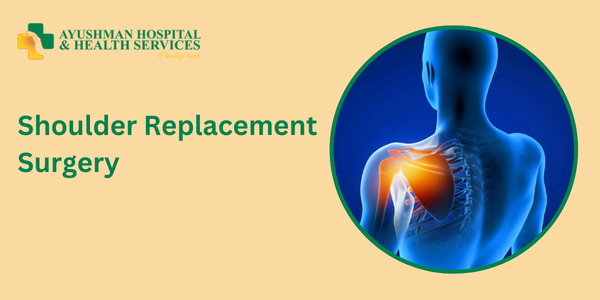Shoulder replacement surgery, also known as shoulder arthroplasty, is a medical procedure designed to alleviate pain and restore function in the shoulder joint. This surgery involves replacing damaged parts of the shoulder with artificial components, known as prostheses. It’s commonly recommended for individuals suffering from severe shoulder pain or dysfunction that hasn’t responded to other treatments.
Understanding the Shoulder Joint
The shoulder is a ball-and-socket joint, providing a wide range of motion. It consists of the upper arm bone (humerus) with a rounded head (the ball) that fits into a shallow socket in the shoulder blade (scapula) called the glenoid. This structure allows for versatile arm movements. However, due to its flexibility, the shoulder is susceptible to injuries and degenerative conditions.
When Is Shoulder Replacement Surgery Needed?
Several conditions can damage the shoulder joint, leading to the need for replacement surgery:
- Osteoarthritis: A degenerative joint disease causing the cartilage to wear away, leading to pain and stiffness.
- Rheumatoid Arthritis: An autoimmune disorder causing inflammation in the joint lining, resulting in pain and swelling.
- Post-Traumatic Arthritis: Arthritis developing after a serious shoulder injury, such as a fracture or dislocation.
- Rotator Cuff Tear Arthropathy: Severe arthritis resulting from a long-standing rotator cuff tear.
- Avascular Necrosis: A condition where the blood supply to the head of the humerus is disrupted, causing bone death and joint damage.
- Severe Fractures: Complex shoulder fractures that are difficult to repair may necessitate replacement.
Doctors typically recommend shoulder replacement surgery when these conditions cause significant pain or limit daily activities, and when non-surgical treatments like medications and physical therapy haven’t provided relief.
Types of Shoulder Replacement Surgeries
There are different types of shoulder replacement surgeries, tailored to the specific condition of the patient:
- Total Shoulder Replacement (Anatomic Shoulder Arthroplasty): This involves replacing both the ball and the socket with prosthetic components. The damaged humeral head is replaced with a metal ball, and the glenoid cavity is fitted with a plastic socket. This type is suitable for patients with intact rotator cuff tendons.
- Partial Shoulder Replacement (Hemiarthroplasty): Only the humeral head (the ball) is replaced in this procedure. It’s often recommended when the glenoid cavity is healthy, but the humeral head is damaged.
- Reverse Total Shoulder Replacement: In this surgery, the positions of the ball and socket are switched—a metal ball is attached to the shoulder blade, and a plastic socket is placed on the humerus. This design allows other muscles to compensate for a deficient rotator cuff, making it suitable for patients with severe rotator cuff tears or cuff tear arthropathy.
The Surgical Procedure
Shoulder replacement surgery generally involves the following steps:
- Anesthesia: The patient is given general anesthesia to ensure they are asleep and pain-free during the procedure.
- Incision: A surgeon makes an incision over the shoulder to access the joint.
- Removal of Damaged Tissue: The damaged portions of the humerus and, if necessary, the glenoid are removed.
- Implant Placement: The prosthetic components are inserted. The humeral component is typically a metal ball attached to a stem that fits into the humerus. The glenoid component is a plastic socket that is cemented or pressed into place.
- Closure: The incision is closed with sutures, and the shoulder is bandaged.
The surgery usually takes about two hours, but this can vary based on the complexity of the case.
Recovery and Rehabilitation
Recovery from shoulder replacement surgery involves several stages:
- Hospital Stay: Patients typically stay in the hospital for one to three days post-surgery. During this time, pain is managed with medications, and the medical team monitors for any complications.
- Immobilization: The arm is placed in a sling to keep the shoulder immobilized and allow initial healing.
- Physical Therapy: Rehabilitation begins with gentle exercises to improve range of motion, gradually progressing to strengthening exercises. A physical therapist guides this process, which is crucial for a successful recovery.
- Home Care: Patients are advised on how to care for their shoulder at home, including wound care, activity restrictions, and exercises.
Full recovery can take several months, and adherence to the rehabilitation program significantly influences the outcome.
Potential Risks and Complications
As with any surgery, shoulder replacement carries potential risks:
- Infection: There’s a risk of infection at the incision site or deep within the joint.
- Blood Clots: Clots can form in the veins of the arm, potentially leading to complications.
- Prosthesis Problems: The artificial components can wear down or become loose over time.
- Nerve Injury: Nerves around the shoulder can be damaged during surgery, leading to numbness or weakness.
- Dislocation: The ball of the prosthesis can come out of the socket.
Discussing these risks with the surgical team helps patients make informed decisions and take steps to minimize potential complications.
Success Rates and Benefits
Shoulder replacement surgery has a high success rate. Many patients experience significant pain relief and improved shoulder function, enabling them to return to daily activities they previously found difficult. Studies have shown that approximately 95% of patients have pain-free function one year after surgery.
🌐 Visit: www.ayushmanhhs.in
Would you like more information on cost estimates, insurance coverage, or rehabilitation programs?






